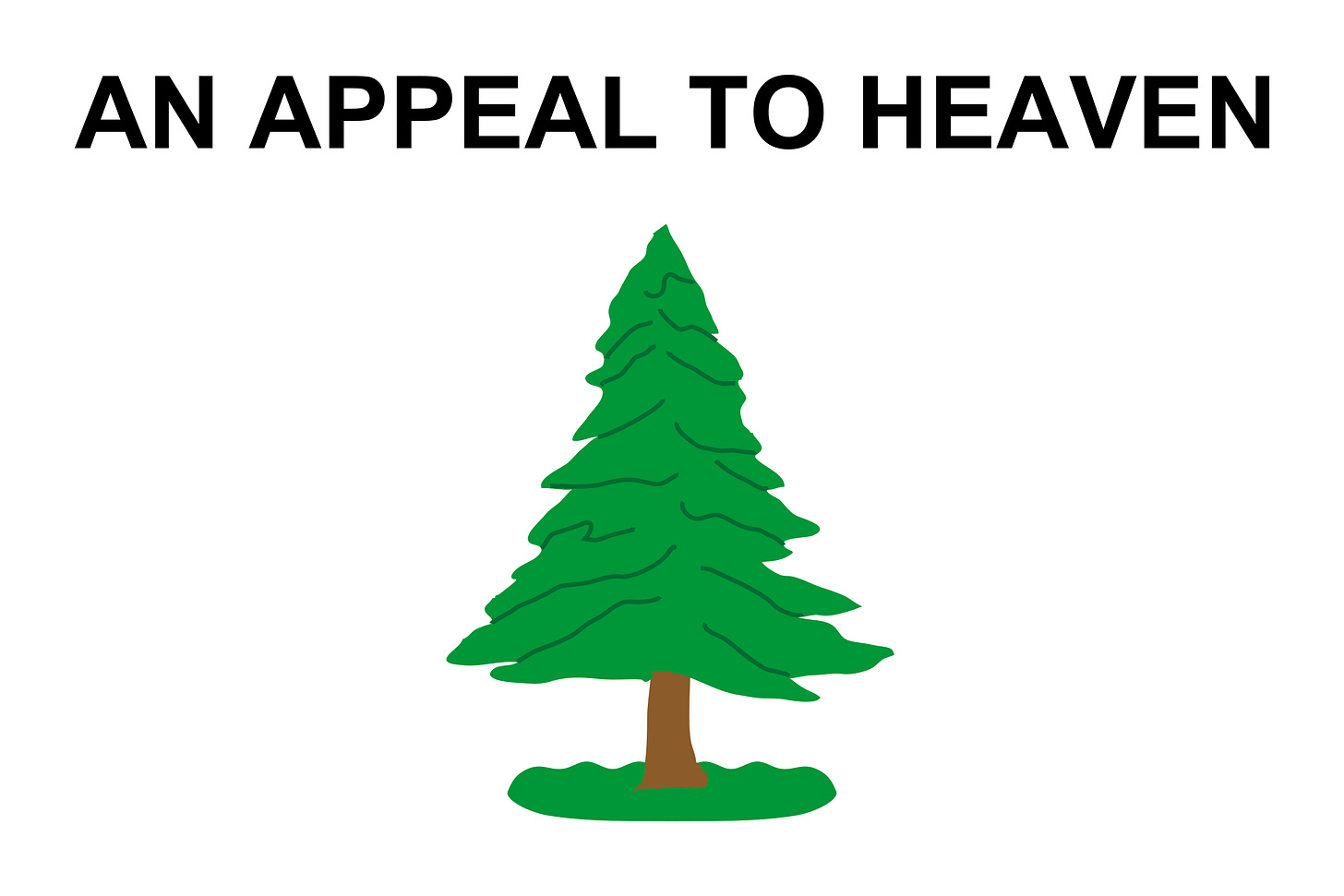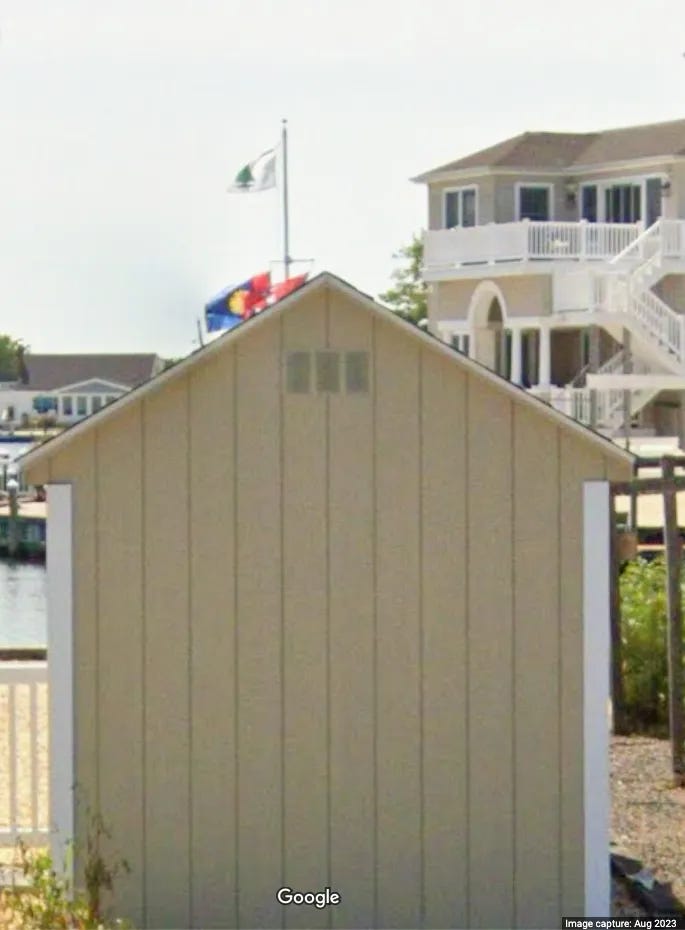Today has started out as an interesting day - another one where I woke up to the whistle of a train, a beautiful day of crystal clear, cool, morning desert air, brewed myself a cup of pour-over coffee, settled in to read the news, then gulped and wondered, “What the hell?!” I was going to write about the NYT’s 1619 Project controversy today. But an appeal to heaven has taken precedence.
A few days ago Supreme Court justice Samuel Alito flew a ‘Stop the Steal (of the 2020 presidential election)’ over his house while claiming that it was all his wife’s doing. A wife who evidently is as unaware as her husband that he sits on the non-partisan Supreme Court of the United States. The January 6th insurrection, you hopefully are aware by now, was, as violent racist Oath Keepers spokesperson Jason Van Tatenhove said to the January 6th Congressional Committee investigating the insurrection, “This was all about race.” Believe him.
Today front page news everywhere has been about yet another flag - the so-called ‘Appeal To Heaven’ flag - also co-opted by the good, patriotic folks of the White supremacist ‘Stop The Steel’ movement that Supreme Court Justice Sam Alito flew over yet another house he owns in continued support of the far-right movement to re-imagine the formerly proud ‘Melting Pot’ of the world into a White refuge. What the hell?!?!
The Pine Tree flag denotes “An Appeal To Heaven.” This expression was used by many, including John Locke in his Second Treatise on Civil Government (1690) as part of the intelligence refuting the “divine right” of Kings to rule the people. By true and natural right, an Appeal To Heaven was a force behind the revolution by the people against such rule. It gave them hope under seemingly unsurmountable odds.
Photo credited to Google Street View
This revelation of the latest Supreme Court flag comes on the same day and alongside headlines about the Supreme Court - the same Supreme Court that Alito sits on - of a decision the court announced today to reverse a lower court ruling and let stand a South Carolina racial gerrymandering that the lower court had ruled against and described as so egregious as to amounting to a “bleaching” of the voting district. I guess the Supreme Court didn’t see any issues with “bleaching” a voting district. What the hell?
This court ruling is from the same court that gutted the long-standing and long useful Voting Rights Act enacted in 1965 and gutted almost exactly 11 years ago. It is highly unlikely that South Carolina would have been allowed to enact this piece of racial gerrymandering if the court - the court Alioto sits on - had not gutted he VRA.
Originally, legislators hoped that within five years of its passage, the issues surrounding the 1965 Voting Rights Act would be resolved and there would be no further need for its enforcement-related provisions. They were wrong. Congress had to extend these provisions in 1970, 1975, 1982 and most recently in 2007, this time for 25 years.
Enforcement measures in Section 5 included:
Requirements for certain jurisdictions with a history of disenfranchising voters to obtain approval or "preclearance" from the U.S. Department of Justice or the U.S/ District Court in D.C. before they can make any changes to voting practices or procedures. They must prove that the proposed change does not denying or infringe on the right to vote on account of race or color.
Requirements for certain jurisdictions to provide language assistance to voters in communities where there is a concentration of citizens who do aren't proficient in English to actively participate in the electoral process. This provision was added to the Voting Rights Act in 1975.
Federal election examiners and observers for certain jurisdictions where there is evidence of attempts to intimidate minority voters at the polls.
In Shelby County v. Holder, a 5–4 majority mothballed the law’s Section 5, which required states with a history of racial discrimination in voting to get certification in advance, or “pre-clearance,” that any election change they wanted to make would not be discriminatory. The Supreme Court did this by holding that the formula used to determine which states and localities had to follow the Section 5 protocols was out of date. For nearly 50 years, Section 5 had assured that voting changes in several states — including Alabama, Alaska, Arizona, Georgia, Louisiana, Mississippi, South Carolina, Texas, and Virginia — were transparent, vetted, and fair to all voters regardless of race.
Prior to Shelby, the Brennan Center warned that without the protections provided by Section 5, states might seek to reinstate or push a wave of discriminatory voting measures that were previously blocked or deterred by the law, threatening the rights of minority voters across the country to cast a ballot. Unfortunately, that’s exactly what has happened.
Within 24 hours of the Shelby ruling, Texas announced that it implement a strict photo-ID law. An ID that many Black and Brown voters do not possess. In the years since, the Brennan Center has consistently found that states previously covered by the preclearance requirement have engaged in significant efforts to disenfranchise voters. A 2018 Brennan Center report concluded that previously covered states have increased the purging of voters after Shelby when the purge rates in non-Shelby states stayed the same.
Chief Justice John Roberts, in his Shelby opinion, asserted that the Section 5 requirements were no longer necessary, that times had changed since 1965. “The conditions that originally justified these measures no longer characterize voting in the covered jurisdictions,” he wrote. Say WHAT?!? Only a White person of unusual unearned privilege, wealth, power, and prestige could have thought something so stupid. He likely had help from Sam Alioto.
And as long I’m kinda riled up today and experiencing certain negative feelings about people who claim to be patriots but who seem to hate the version of America that our founding fathers - flawed as they were - seemed to espouse, I’m going to write about Majorie Taylor Greene. Greene seems to be making even more noise and grabbing even more headlines than usual because of her very public spat with Texas Representative Jasmine Crockett - who is Black - over Crockett’s eyelashes interfering with her ability to read.
Rep. Jasmine Crockett
Rep. Marjorie Taylor Greene
I have no idea whatsoever what makes Marjorie Taylor Greene the way she is. But I know a few things about her. I know that she was born and raised in a place in Georgia with a pretty violent racist history.
From The Atlantic: “Forsyth County was a calm, quiet, ordered place. But it had a history. In September 1912, an 18-year-old white girl was found bloodied and barely breathing in the woods lining the Chattahoochee River; she died two weeks later. Within 24 hours of her discovery, four Black men had been arrested and charged with assault. A white mob dragged one of the suspects from his cell and hanged him from a telephone pole. Two others were tried and executed. White residents then decided to undertake nothing short of a racial cleansing. On horseback, armed with rifles and dynamite, they drove out virtually all of the county’s Black population—more than 1,000 people. So successful were their efforts that the county would experience the modern civil-rights era vicariously at best. There were no whites only signs to fuss over in Cumming, because there were no Black people to keep separate.
In January 1987, a white resident organized a “Walk for Brotherhood” to commemorate what had happened 75 years earlier. The project was complicated by the immediate wave of death threats he received. Arriving from Atlanta, the civil-rights leader Hosea Williams called Forsyth the most racist county in the South. Oprah Winfrey came down to cover the event. But most people in Forsyth ignored the whole affair; broach it in conversation, and you were considered a pot-stirrer. George Pirkle, the county’s resident historian, was reminded of this as recently as 2011, when he readied for publication The Heritage Book of Forsyth County. He told the mayor of Cumming about his plans to include the region’s Black history in the volume, and got an incredulous response: “Well, why in the world would you want to do that?” As Martha McConnell, the local historical society’s co-president then and now, told me, the subtext was clear: “Don’t be starting things.””
I don’t know what affect her hometown history had on her. I only know she comes across as awfully racist. My guess is she’s pretty supportive of Judge Alioto. Here’s a deeper, more graphic account of Marjorie’s upbringing: https://www.yahoo.com/news/sickening-history-marjorie-taylor-greene-095713316.html
Yep, I’m back to, “What the hell”?
Sources:
https://naacp.org/find-resources/history-explained/legislative-milestones/voting-rights-act-1965
https://www.brennancenter.org/our-work/analysis-opinion/7-years-gutting-voting-rights
https://www.huffpost.com/entry/supreme-court-south-carolina-gerrymander_n_66181e90e4b011e99abd60f8
https://steotwawki.com/independence-day-an-appeal-to-heaven/
https://www.yahoo.com/news/sickening-history-marjorie-taylor-greene-095713316.html







